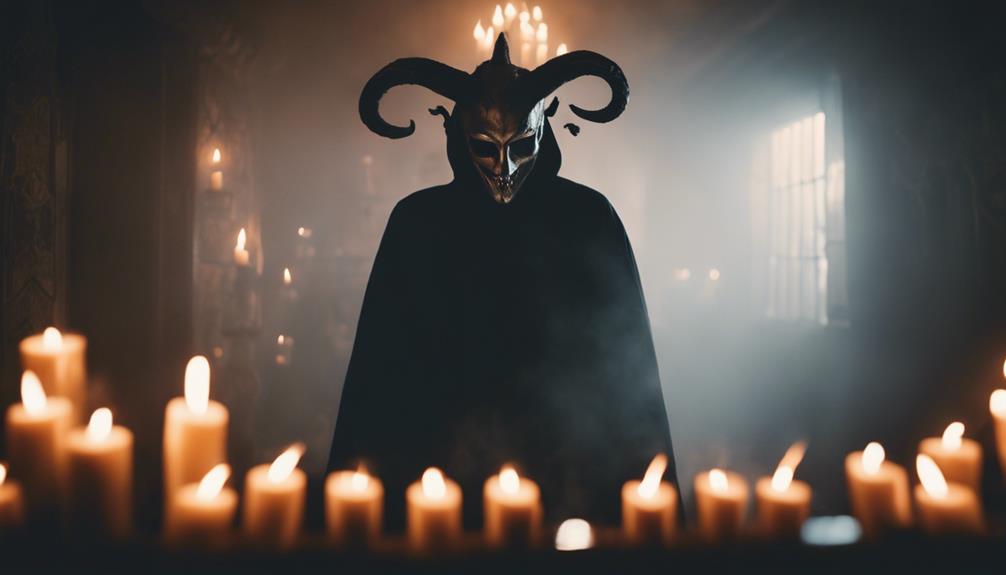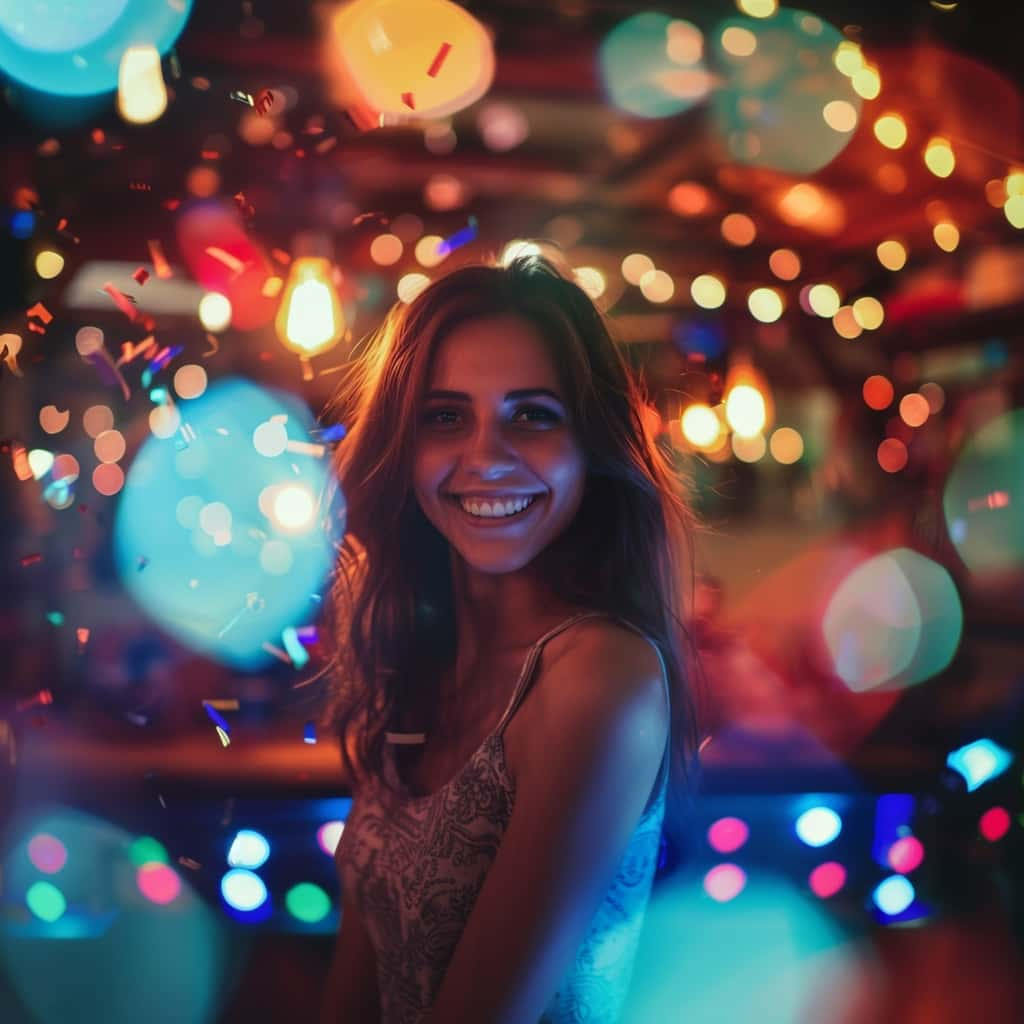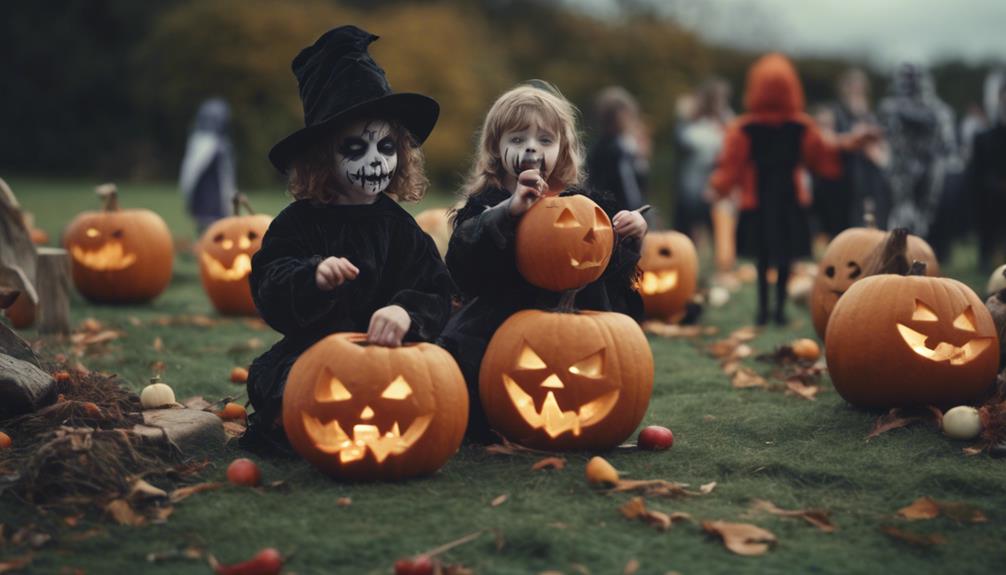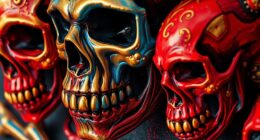Halloween's origins tie back to ancient Celtic practices, especially the Samhain festival, where the boundary between worlds was thinnest. This thin boundary led to beliefs in malevolent spirits crossing over, blending pagan and Christian traditions. Bonfires and costumes sought protection from these entities. Over time, Halloween evolved with jack-o'-lanterns and trick-or-treating, reflecting a mix of customs to ward off evil spirits. Demons played a role in Celtic Halloween customs, with bonfires aimed at warding them off and costumes used for disguise. Discover more about Halloween's intriguing history by exploring its dark origins.
Key Takeaways
- Samhain festival marks thin veil between living and dead, influencing Halloween's demonic associations.
- Blend of Celtic and Christian beliefs led to Halloween's demonic symbolism.
- Bonfires and costumes in Celtic traditions aimed to ward off malevolent entities.
- Trick-or-Treating may have origins in appeasing evil spirits during Samhain.
- Commercialization has emphasized Halloween's demonic elements over time.
Origins of Halloween's Demonic Associations
The origins of Halloween's demonic associations can be traced back to the historical connection between the Celtic festival of Samhain and the belief in evil spirits freely roaming the earth. During Samhain, which marked the end of the harvest season and the beginning of winter, the Celts believed that the barrier between the living and the dead was at its thinnest. This thin veil allowed malevolent entities to cross over into the mortal domain, causing fear and uncertainty among the people.
The merging of Samhain with Christian traditions, particularly the establishment of All Saints Day on November 1 by Pope Gregory III, further solidified the perception of Halloween as a night when evil spirits roamed freely. The blend of pagan and Christian elements created an atmosphere where supernatural beliefs intertwined with religious practices.
As a result, the folklore surrounding Halloween, including customs like carving Jack-o-lanterns and wearing costumes to ward off evil spirits, reinforced the idea of demonic associations with the holiday. These traditions served as both entertainment and protection against malevolent forces believed to be active on Halloween night.
Samhain: Bridge to the Otherworld

Why did the Celts view Samhain as a bridge to the Otherworld?
Samhain, a Celtic festival, marked the end of the harvest season and the onset of winter. The Celts believed that during Samhain, the veil between the living and the dead was at its thinnest, allowing spirits to cross over into the mortal domain. To protect themselves from these wandering spirits, the Celts lit bonfires and donned costumes as a form of disguise.
This festival was seen as a time of change, where the boundary between the natural and supernatural worlds blurred, creating an opportunity for spirits to interact with the living. The customs and beliefs surrounding Samhain laid the foundation for what would later become Halloween, with elements like costumes, bonfires, and the idea of a connection between the living and the dead persisting through the centuries.
The Celts' perception of Samhain as a bridge to the Otherworld influenced the development of traditions that are still observed in modern Halloween celebrations.
Evolution of Halloween's Demonic Symbolism

With Halloween's demonic symbolism evolving from ancient beliefs about spirits crossing over during Samhain, the holiday's association with demons has deep historical roots. As Christian traditions blended with pagan practices, the day became intertwined with the concept of evil entities. The evolution of Halloween's demonic imagery can be seen in various customs associated with the holiday.
| Evolution of Halloween's Demonic Symbolism |
|---|
| Origins |
| Samhain festival crossing the line between the living and the dead. |
| Christian Influence |
| All Saints' Day merging with pagan practices, adding a divine aspect. |
| Jack-o'-lanterns |
| Initially used to ward off evil spirits, contributing to the demonic theme. |
| Trick-or-Treating |
| Possibly derived from offering treats to appease malevolent spirits. |
| Commercialization |
| Popular culture emphasizing the demonic aspects for entertainment. |
Through the ages, Halloween's association with demons has evolved, incorporating elements from various cultural and religious practices to shape the holiday as it is understood today.
Demons in Celtic Halloween Traditions

In Celtic Halloween traditions, amidst the flickering bonfires and disguised revelers, demons prowled the night freely during Samhain, embodying the fears of an ancient belief system. The Celts believed in the presence of supernatural entities, with demons being particularly active and powerful during this time. To ward off these malevolent spirits, they engaged in various practices:
- Bonfires: The Celts lit bonfires on October 31 to keep demons at bay and safeguard themselves from their influence.
- Costumes: Wearing costumes was a way to disguise oneself from demons, as they believed that blending in with the spirits could prevent harm.
- Offerings: Food offerings were left outside homes as a gesture to appease demons and make sure they wouldn't cause harm to the living during Samhain.
These customs reflect a deep-rooted belief in the presence of demons and spirits during Celtic Halloween traditions, showcasing how the ancient Celts navigated the thin veil between the living and the supernatural world.
Unveiling Halloween's Dark Origins

Amidst the ancient Celtic festival of Samhain, where demons prowled freely and fears took shape, lies the dark origins of Halloween. Samhain, marking the shift from summer to winter, was believed to have a thin veil between the living and the dead, allowing spirits to roam the earthly domain. This supernatural connection during Samhain led to Halloween's association with the otherworldly and mysterious.
The merging of Samhain with Christian traditions, particularly All Saints Day, played a pivotal role in shaping Halloween into the holiday we recognize today. Despite its Christian influences, Halloween's historical ties to honoring the deceased and embracing supernatural elements have sparked debates about its potential demonic roots. While Halloween itself isn't inherently demonic, its deep-seated connections to ancient beliefs about the spirit world have contributed to its enigmatic and sometimes sinister reputation.
Understanding the historical underpinnings of Halloween sheds light on how this modern celebration evolved from ancient customs and beliefs, intertwining the spiritual and the supernatural in a unique cultural tapestry.
Frequently Asked Questions
What Is the Dark Origin of Halloween?
The dark origin of Halloween dates back to the ancient Celtic festival of Samhain, marking the end of summer and the thinning of the veil between the living and the dead.
This merging with the Roman festival of Feralia post-conquest introduced elements that influenced the Christianization of the holiday.
Pope Gregory III's declaration of November 1 as All Saints Day transformed the pagan festival into a Christian observance, with associations to honoring the dead and supernatural elements surrounding the shift of seasons.
What Is the Evil History of Halloween?
Halloween's evil history is often linked to its pagan origins and the belief in a thin veil between the living and the dead during Samhain. Some view the holiday as conflicting with Christian beliefs due to its ties to honoring martyrs.
Commercialization has furthered the perception of Halloween as sinister, with spooky costumes reinforcing this idea. Despite lacking concrete evidence of demonic practices, misunderstandings about Halloween's traditions persist, fueling the belief in its dark history.
What Is the Spiritual Truth Behind Halloween?
The spiritual truth behind Halloween lies in its connection to All Saints Day, a Christian celebration honoring saints and emphasizing good over evil. This holiday serves as a time to remember the faithful departed and the hope of resurrection.
While Halloween's origins may have pagan roots, its modern observance focuses on community, fun, and creativity rather than demonic associations. It's a time for reflection, remembrance, and celebrating life.
What Is the True Story Behind Halloween?
The true story behind Halloween revolves around a Christianized version of ancient traditions, emphasizing honoring saints and departed souls. Halloween's origins trace back to the Celtic festival of Samhain, marking the shift to winter with a thin veil between the living and the dead.
Over time, this holiday evolved with Roman and Christian influences, culminating in the modern celebration on October 31. This day now focuses on fun, costumes, and community festivities rather than demonic roots.
Conclusion
To sum up, the dark origins of Halloween's demonic associations can be traced back to ancient Celtic traditions and beliefs surrounding Samhain. This holiday served as a bridge to the Otherworld, where spirits and demons were said to roam freely.
Over time, Halloween evolved, incorporating elements of these demonic symbols into its modern celebrations. By understanding the historical context of Halloween, we can appreciate the rich tapestry of cultural influences that have shaped this spooky holiday.










